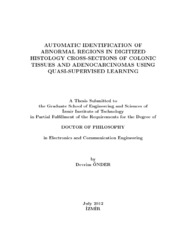Please use this identifier to cite or link to this item:
https://hdl.handle.net/11147/2928Full metadata record
| DC Field | Value | Language |
|---|---|---|
| dc.contributor.advisor | Karaçalı, Bilge | - |
| dc.contributor.author | Önder, Devrim | - |
| dc.date.accessioned | 2014-07-22T13:48:37Z | - |
| dc.date.available | 2014-07-22T13:48:37Z | - |
| dc.date.issued | 2012 | - |
| dc.identifier.uri | http://hdl.handle.net/11147/2928 | - |
| dc.description | Thesis (Doctoral)--Izmir Institute of Technology, Electronics and Communication Engineering, Izmir, 2012 | en_US |
| dc.description | Includes bibliographical references (leaves: 140-147) | en_US |
| dc.description | Text in English; Abstract: Turkish and English | en_US |
| dc.description | xiv, 147 leaves | en_US |
| dc.description.abstract | In this thesis, a framework for quasi-supervised histopathology image texture identi- cation is presented. The process begins with extraction of texture features followed by a quasi-supervised analysis. Throughout this study, light microscopic images of the hematoxylin and eosin stained colorectal histopathology sections containing adenocarcinoma were quantitatively analysed. The quasi-supervised learning algorithm operates on two datasets, one containing samples of normal tissues labelled only indirectly and in bulk, and the other containing an unlabelled collection of samples of both normal and cancer tissues. As such, the algorithm eliminates the need for manually labelled samples of normal and cancer tissues commonly used for conventional supervised learning and signicantly reduces the expert intervention. Several texture feature vector datasets corresponding to various feature calculation parameters were tested within the proposed framework. The resulting labelling and recognition performances were compared to that of a conventional powerful supervised classier using manually labelled ground-truth data that was withheld from the quasi-supervised learning algorithm. That supervised classier represented an idealized but undesired method due to extensive expert labelling. Several vector dimensionality reduction techniques were evaluated an improvement in the performance. Among the alternatives, the Independent Component Analysis procedure increased the performance of the proposed framework. Experimental results on colorectal histopathology slides showed that the regions containing cancer tissue can be identied accurately without using manually labelled ground-truth datasets in a quasi-supervised strategy. | en_US |
| dc.language.iso | en | en_US |
| dc.publisher | Izmir Institute of Technology | en_US |
| dc.rights | info:eu-repo/semantics/openAccess | en_US |
| dc.subject.lcsh | Supervised learning (Machine learning) | en |
| dc.subject.lcsh | Pathology | en |
| dc.subject.lcsh | Histology, Pathological | en |
| dc.title | Automatic Identification of Abnormal Regiones in Digitized Histology Cross-Sections of Colonic Tissues and Adenocarcinomas Using Quasi-Supervised Learning | en_US |
| dc.type | Doctoral Thesis | en_US |
| dc.department | Thesis (Doctoral)--İzmir Institute of Technology, Electrical and Electronics Engineering | en_US |
| dc.relation.publicationcategory | Tez | en_US |
| dc.identifier.wosquality | N/A | - |
| dc.identifier.scopusquality | N/A | - |
| item.openairecristype | http://purl.org/coar/resource_type/c_18cf | - |
| item.languageiso639-1 | en | - |
| item.openairetype | Doctoral Thesis | - |
| item.grantfulltext | open | - |
| item.fulltext | With Fulltext | - |
| item.cerifentitytype | Publications | - |
| Appears in Collections: | Phd Degree / Doktora | |
Files in This Item:
| File | Description | Size | Format | |
|---|---|---|---|---|
| T001017.pdf | DoctoralThesis | 6.67 MB | Adobe PDF |  View/Open |
CORE Recommender
Sorry the service is unavailable at the moment. Please try again later.
Items in GCRIS Repository are protected by copyright, with all rights reserved, unless otherwise indicated.